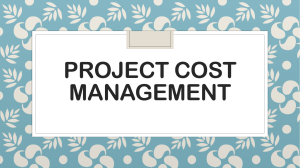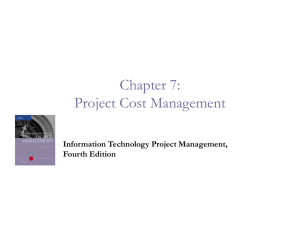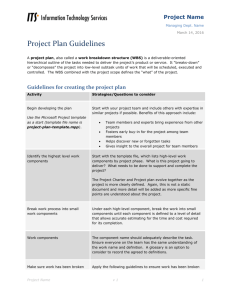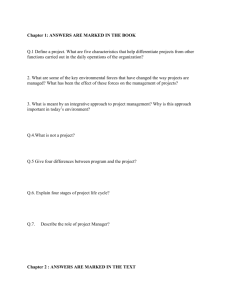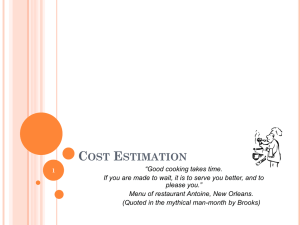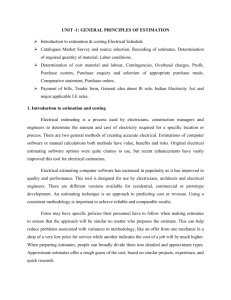Classroom Notes I - Alliance University, Department of Continuing
advertisement
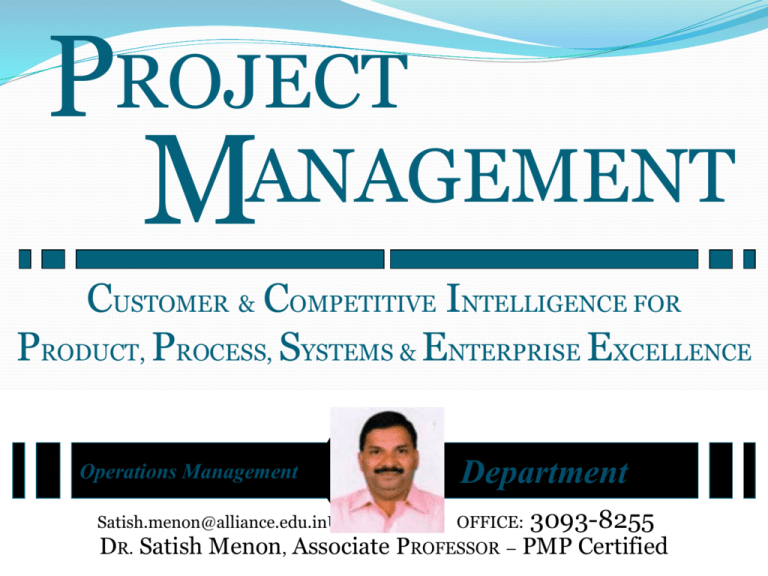
PROJECT M ANAGEMENT CUSTOMER & COMPETITIVE INTELLIGENCE FOR PRODUCT, PROCESS, SYSTEMS & ENTERPRISE EXCELLENCE Operations Management Satish.menon@alliance.edu.inU Department OFFICE: 3093-8255 DR. Satish Menon, Associate PROFESSOR – PMP Certified What is Cost Cost is a resource sacrificed or foregone to achieve a specific objective or something given up in exchange. What is Project Cost Management? Project cost management includes the processes required to ensure that the project is completed within an approved budget. Project managers must make sure their projects are well defined, have accurate time and cost estimates and have a realistic budget that they were involved in approving. Project Cost Management Processes There are three project cost management processes: Cost estimating: developing an approximation or estimate of the costs of the resources needed to complete a project Cost budgeting: allocating the overall cost estimate to individual work items to establish a baseline for measuring performance Cost control: controlling changes to the project budget Why you use Project Coststart? Management Processes Where doshould you WhyRisk you should useRisk Risk Management Management inManagement: Customs Next Next Next Basic Principles of Cost Management Cash flow analysis determines the estimated annual costs and benefits for a project and the resulting annual cash flow. Too many projects with high cash flow needs in the same year may not be able to be supported which will impact profitability. Tangible costs or benefits are those costs or benefits that an organization can easily measure in dollars A task that was allocated $150,000 but actually costs $100,000 would have a tangible benefit of $50,000 if the assets allocated are used for other projects Intangible costs or benefits are costs or benefits that are difficult to measure in monetary terms Costs – resources used to research related areas of a project but not billed to the project Benefits – goodwill, prestige, general statements of improved productivity not easily translated in dollars Basic Principles of Cost Management Direct costs are costs that can be directly related to producing the products and services of the project Salaries, cost of hardware and software purchased specifically for the project. Indirect costs are costs that are not directly related to the products or services of the project, but are indirectly related to performing the project Cost of electricity, paper towels Sunk cost is money that has been spent in the past; when deciding what projects to invest in or continue, you should not include sunk costs To continue funding a failed project because a great deal of money has already been spent on it is not a valid way to decide on which projects to fund Sunk costs should be forgotten Basic Principles of Cost Management Learning curve theory states that when many items are produced (or tasks are performed) repetitively, the unit cost of those items decreases in a regular pattern as more units are produced (or more tasks performed) Reserves are dollars included in a cost estimate to mitigate cost risk by allowing for future situations that are difficult to predict Contingency reserves allow for future situations that may be partially planned for (sometimes called known unknowns) and are included in the project cost baseline Recruiting and training costs for expected personnel turnover during a project Management reserves allow for future situations that are unpredictable (sometimes called unknown unknowns) Extended absence of a manager; supplier goes out of business Cost Estimating •After developing a good resource requirements list, PMs and their teams must develop several estimates of the costs for these resources •Project managers must take cost estimates seriously if they want to complete projects within budget constraints •It’s important to know the types of cost estimates, how to prepare cost estimates, and typical problems associated with IT cost estimates Cost Estimating •A rough order of magnitude (ROM) estimate provides an estimate of what a project will cost. •Also referred to as a ballpark estimate, a guesstimate, a swag, or a broad gauge. •Done very early in a project, often three or more years prior to project completion, or even before a project is officially started to help PMs make project selection decisions. •Accuracy is typically -50 percent to +100 percent, meaning the project’s actual costs could be 50 percent below the ROM estimate or 100 percent above. Cost Estimating •A budgetary estimate is used to allocate money into an organization’s budget. •Many organizations develop budgets at least two years into the future. Budgetary estimates are made one to two years prior to project completion. •The accuracy of budgetary estimates is typically 10% to +25% A budgetary estimate that actually costs $100,000 would range between $90,000 to $125,000. Cost Estimating A definitive estimate provides an accurate estimate of project costs (most accurate of the three types). Definitive estimates are used for making many purchasing decisions for which accurate estimates are required and for estimating final project costs. For example, if a project involves purchasing 1000 personal computers from an outside supplier in the next three months, a definitive estimate would be required to aid in evaluating supplier proposals and allocating the funds to pay the chosen supplier. Definitive estimates are made one year or less prior to project completion Accuracy range is normally -5% to +10% Why you use Where doshould you WhyRisk you should useRisk Risk Management Types of Coststart? Estimates Management inManagement: Customs A definitive estimate provides an accurate estimate of project costs (most accurate of the three types). Definitive estimates are used for making many purchasing decisions for which accurate estimates are required and for estimating final project costs. For example, if a project involves purchasing 1000 personal computers from an outside supplier in the next three months, a definitive estimate would be required to aid in evaluating supplier proposals and allocating the funds to pay the chosen supplier. Next Next Next Cost Estimating It is important to provide supporting details (assumptions, project scope, WBS, etc) used in computing estimates so that it will be easier to prepare updates as needed or similar estimates on other projects. Cost Management Plan A cost management plan is a document that describes how the organization will manage cost variance on the project For example, how to respond to proposals from suppliers that are higher or lower than estimates A large percentage of total project costs are often labor costs, so project managers must develop and track estimates for labor Many organizations estimate the number of people or hours they need by department or skill over the life cycle of a project Cost Management Plan Analogous or top-down estimates: use the actual cost of a previous, similar project as the basis for estimating the cost of the current project. How similar the current and previous project are determines the accuracy of the estimate. Using a different language or hardware can skew the estimate. Bottom-up estimates or Activity Based Costing : involve estimating individual work items or activities and summing them to get a project total The smaller the work items, the better the estimate but these estimates are usually time intensive and expensive to develop Cost Estimation Tools and Techniques Parametric modeling: uses project characteristics (parameters) in a mathematical model to estimate project costs For example, a model might provide an estimate of $50 per line of code for a s/w development project based on the programming language, level of expertise of the programmers, size and complexity of the data involved, etc Some models may be simpler such as a $10,000 ballpark estimate per workstation in a large office automation project based on history of similar projects during the same time period Cost Budgeting •Cost budgeting involves allocating the project cost estimate to individual work items over time •The WBS is a required input to the cost budgeting process since it defines the work items •An important goal is to produce a cost baseline A time-phased budget that project managers use to measure and monitor cost performance •Estimating costs for each major project activity over time provides management with a foundation for project cost control •Cost budgeting also provides info for project funding requirements –at what point(s) in time will the money be needed Cost Control Project cost control includes: •Monitoring cost performance •Ensuring that only appropriate project changes are included in a revised cost baseline •Informing project stakeholders of authorized changes to the project that will affect costs •Many organizations around the globe have problems with cost control Cost Control •Performance review meetings can be a powerful tool to help control project costs •Knowing you have to report on your progress is an incentive for people to perform better •Performance measurement is another important tool for cost control •There are many general accounting approaches for measuring cost performance but earned value management is a tool unique to project management Earned Value Management (EVM) •EVM is a project performance measurement technique that integrates scope, time, and cost data •Given a baseline (original plan plus approved changes), you can determine how well the project is meeting its goals •You must enter actual information periodically to use EVM • Was a WBS item completed or approximately how much of the work was completed • Actual start and end dates • Actual cost •More and more organizations around the world are using EVM to help control project costs Earned Value Management Terms The planned value (PV), formerly called the budgeted cost of work scheduled (BCWS), also called the budget, is that portion of the approved total cost estimate planned to be spent on an activity during a given period Actual cost (AC), formerly called actual cost of work performed (ACWP), is the total of direct and indirect costs incurred in accomplishing work on an activity during a given period $20,000 AC to accomplish task over two weeks - $15K AC week 1and $5K week 2 The earned value (EV), formerly called the budgeted cost of work performed (BCWP), is an estimate of the value of the physical work actually completed EV is based on the original planned costs for the project or activity and the rate at which the team is completing work on the project or activity to date Rate of Performance • Rate of performance (RP) is the ratio of actual work completed to the percentage of work planned to have been completed at any given time during the life of the project or activity Rate of Performance Negative numbers for cost and schedule variance indicate problems in those areas If CV is negative it means that performing the work cost more than planned A negative SV means that it took longer than planned to perform the work CPI can be used to estimate the projected cost of completing the project based on performance to date (EAC) =1:the planned and actual costs are the same; <1: over budget; >1: under budget SPI can be used to estimate the projected time to complete the project =1: on schedule; <1 behind schedule; >1 ahead of schedule Project Portfolio Management Many organizations collect and control an entire suite of projects or investments as one set of interrelated activities in a portfolio Five levels for project portfolio management 1. Put all your projects in one database 2. Prioritize the projects in your database 3. Divide your projects into two or three budgets based on type of investment 4. Automate the repository 5. Apply modern portfolio theory, including risk-return tools that map project risk on a curve End of Session
